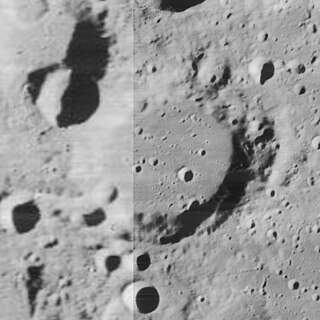Cleostratus is a masculine name from Ancient Greece. Cleostratus may refer to:
- Cleostratus, an ancient Greek astronomer
- Cleostratus (mythology), a young boy in Greek mythology
- Cleostratus (crater), a lunar crater
Cleostratus is a masculine name from Ancient Greece. Cleostratus may refer to:

In Greek mythology, Amalthea or Amaltheia is the most-frequently mentioned foster-mother of Zeus.

In Greek mythology and later art, the name Hesione refers to various mythological figures, of whom the Trojan princess Hesione is most known.
Dryops may refer to:
In Greek mythology, Lilaea or Lilaia may refer to two different women:
Diana most commonly refers to:

Cleostratus is a lunar impact crater near the northwest limb of the Moon. It lies to the northeast of the crater Xenophanes, and west-southwest of the prominent Pythagoras. From the Earth this crater appears highly elongated due to foreshortening.

Cleostratus was an astronomer of ancient Greece. He was a native of Tenedos. He is believed by ancient historians to have introduced the zodiac and the solar calendar. According to J. Webb, Cleostratus took his ideas from the Babylonians.
In Greek mythology, Calyce or Calycia is the name of several characters.
Anaxandra was an ancient Greek female artist and painter from Greece. She was the daughter and student of Nealkes, a painter of mythological and genre scenes. She painted c. 228 B.C. She is mentioned by Clement of Alexandria, the 2nd century Christian theologian, in a section of his Stromateis (Miscellanies) entitled "Women as Well as Men Capable of Perfection". Clement cites a lost work of the Hellenistic scholar Didymus Chalcenterus as his source.
Adrastus was a legendary king of Argos.
In Greek mythology, Borysthenis may refer to two distinct individuals:
Heracleitus or Heraclitus may refer to:
Telamon was the father of the hero Ajax in Greek mythology.
Harpalus was an ancient Greek astronomer who corrected the cycle of Cleostratus and invented the Nine Year Cycle.
Achelous is a river god in Greek mythology.
In Greek mythology, Alcyoneus is a young and handsome man from Crissa, the only son of Diomos and Meganeira. He features in a short myth where he is chosen to be the sacrificial victim for a beast called Sybaris that terrorised Delphi and the surrounding area, a prototypical example of the hero slays a monster and saves a princess tale. His tale survives in the writings of second-century author Antoninus Liberalis, and might originate from an older work by Nicander of Colophon.
In Greek mythology, Lynceus may refer to the following personages.
In Greek mythology, Menestratus is a Thespian man who dies trying to slay a dragon in an attempt to save his lover from the monster. His story is recounted in Description of Greece, a second-century work by Greek traveller and geographer Pausanias.
In Greek mythology, Cleostratus is a teenage boy from Thespiae, a town in Boeotia, who is chosen to be offered to a dragon in a yearly sacrifice to the monster, until he is saved by his lover Menestratus. His and Menestratus's myth is known thanks to Description of Greece, a second-century work by Greek traveller and geographer Pausanias. Cleostratus' myth is an early example of the hero-tale where the hero saves a damsel or princess from a vicious dragon.